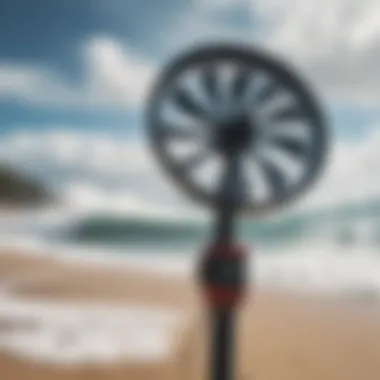Understanding Anemometers for Surfing Safety and Performance


Intro
Anemometers play a crucial role in understanding surf conditions, serving as a necessary tool for surfers who want to maximize performance while ensuring safety. Wind can significantly influence wave height and quality, making precise wind measurement essential. Surfers, whether they are seasoned pros or weekend warriors, benefit greatly from the insights that anemometers provide. Surfing is not just about catching a wave; it’s about reading the wind and knowing what it brings.
In this article, we’ll explore the ins and outs of anemometers: what they are, how they function, and why they are so vital for surfers who want to navigate the complexities of the ocean. We’ll cover different types of anemometers, the technology behind them, and their applications in the unforgettable world of surfing. It's not merely a technical dive; it's about understanding how these instruments intersect with the very essence of surf culture and sustainable practices.
Preamble to Anemometers
In the realm of surfing, understanding wind conditions is akin to knowing the tides. Anemometers, the instruments designed to measure wind, play a crucial role in predicting and enhancing the surfing experience. Without these devices, surfers would be navigating the oceanic dance of waves largely in the dark—at the mercy of nature's whims. This section will delve into the fundamentals of anemometers, exploring what they are, their historical journey, and their indispensable relevance for those who ride the waves.
Definition of Anemometer
An anemometer is a device used to measure wind speed and direction—two vital elements for surfers. To put it plainly, it's the surfer's best friend when it comes to anticipating the conditions ahead. The typical unit of measurement is meters per second or kilometers per hour, serving as a compass for surfers in understanding the force of the elements they will face. Picture it as a tool that translates the whispers of the wind into actionable insights, allowing surfers to make informed decisions about when to hit the waves.
Historical Context
The origins of anemometers date back to ancient Greece, where philosophers and scientists began exploring wind behavior. The first documented anemometer was created in the late 15th century by Leonardo da Vinci. Fast forward a few hundred years and we see various advancements enhancing these instruments from simple mechanical devices to more sophisticated digital systems. In the context of surfing, this evolution mirrors the progression of the sport itself, illustrating the increasing importance of precision and technology in optimizing the riding experience. As equipment became more accurate, surfers could better gauge the conditions, leading to improved safety and performance.
Importance in Surfing
The winds play a dramatic role in shaping surf conditions. For surfers, having access to reliable anemometer data can mean the difference between an exhilarating day on the surfboard and a rather treacherous encounter with unruly swells. Understanding wind patterns helps surfers not only catch the best waves but also stay safe by avoiding dangerously high winds. Furthermore, some types of anemometers come with features that help interpret complex wind data, enhancing strategic decision-making both on-site and in planning sessions. It's not just about riding the waves; it's about riding them wisely.
"Knowledge of wind conditions transforms an average surfing day into an extraordinary one."
Through this exploration, we will uncover how anemometers serve beyond simple wind measurements, fundamentally enhancing the experience and safety of those braving the waves. By the end of this article, surfers from all walks of life should have a clearer perspective on how to select and utilize anemometers to their benefit, ensuring they ride not just the waves, but the winds that shape them.
Types of Anemometers
Understanding the different types of anemometers is key in appreciating their vital role for surfers and environmental advocates alike. Each type serves a unique purpose, boasting its own set of features that make it suitable for various scenarios. Having the right anemometer can make all the difference in ensuring that surfers are well-prepared for the conditions ahead, while also contributing to broader environmental studies.
Mechanical Anemometers
Mechanical anemometers have been around for quite a while, relying on physical components to measure wind speed and direction.
Cup Anemometers
Cup anemometers consist of three or four cups mounted on horizontal arms, allowing them to catch the wind and spin. The key characteristic of these devices is their simplicity. They are easy to use and require minimal maintenance, making them a popular choice among surf enthusiasts.
The unique feature of cup anemometers is their ability to provide accurate average wind speed over time. This means they are well-suited for surfers who want to gauge the general conditions before hitting the waves. However, they can be less effective in highly turbulent conditions, where they might lag in responsiveness.
One main disadvantage is their sensitivity to direction. Since they rely on the cups' rotation to measure speed, if they're pointed slightly off-course, the readings can be skewed.
Vane Anemometers
Vane anemometers, on the other hand, look similar to small wind turbines, incorporating blades that rotate in the wind. The primary aspect of vane anemometers is that they can measure wind direction alongside speed, making them more versatile for surfers looking to understand the wind dynamics at their surf spots.
The key characteristic here is this dual capability, which comes in handy in open water where knowing wind direction can influence wave conditions significantly. Surfers benefit from this since it allows them to make informed decisions about where to paddle out and how to position themselves on the water.
A unique feature of vane anemometers is their fast response time, providing real-time data about fluctuating wind conditions. However, they can be affected by surrounding obstacles like buildings or cliffs that may disrupt true wind patterns, potentially leading to less accurate readings in coastal spots.
Digital Anemometers
With advances in technology, digital anemometers have gained popularity for their precision and ease of use. They tend to offer features that enhance functionality, which makes them vital for those who want detailed measurements.
Hot-Wire Anemometers
Hot-wire anemometers measure airflow by detecting changes in temperature as a current flows through a fine wire. The main advantage is their ability to provide highly accurate measurements in turbulent flows, which can be beneficial for surfers trying to navigate rough waters.
What sets them apart is their sensitivity to small changes in wind speed. For surfers, this can translate to knowing when to stay in or venture out, especially in rapidly changing conditions. Hot-wire devices often come with digital displays that make it easy to read real-time values.
However, one drawback is their fragility. Since they feature fine wires that can be easily damaged, careful handling is essential.


Laser Doppler Anemometers
Laser Doppler anemometers measure wind speed by analyzing the frequency shift of laser light scattered off particles in the air. The main advantage of this method is its ability to capture high-resolution data over a range of flow conditions, making it a cutting-edge choice for scientific research and advanced surfing forecasts.
Their unique feature lies in the non-intrusive nature of the measurement, meaning they can be set up without interfering with the wind flow, ensuring accuracy. This high degree of reliability can be a game-changer for surfers who seek precise data for planning actions in challenging conditions.
That said, the equipment can be pricey, and setup may require expertise, making them less accessible for the casual surfer.
Application-Specific Anemometers
Some anemometers are tailored to specific applications, enhancing their usability in varied contexts.
Portable Anemometers for Surfing
Portable anemometers are designed with surfers in mind. These lightweight, user-friendly devices allow surfers to easily assess wind conditions before a session. The key advantage is their mobility, ensuring that surfers can carry them on their boards or in their backpacks.
These devices might come equipped with features like Bluetooth connectivity for real-time updates, which surfers can access on their smartphones. Yet, they often have a limited range compared to their stationary counterparts, meaning they may not always provide the most accurate long-term data.
Stationary Anemometers for Environmental Monitoring
On the other hand, stationary anemometers are set up in specific locations for ongoing monitoring purposes. Their primary characteristic is durability—often equipped to withstand harsh weather conditions, they provide valuable data over extended periods.
For surfers, understanding long-term wind patterns can inform their surfing decisions, especially in studying seasonal changes in surf. A unique feature of these anemometers is their ability to connect to broader environmental monitoring networks, allowing for comprehensive data analysis.
However, a downside is that stationary models require installation and may not offer immediate readings compared to portable models.
By recognizing the types of anemometers available, surfers can make informed choices about which instruments will best serve their needs while conserving the environment.
Mechanics of Anemometers
Understanding the mechanics behind anemometers is crucial for any surfer looking to enhance their experience on the water. These instruments not only measure wind speed, but also provide insights into the wind’s direction and how it interacts with wave patterns. By grasping the intricate workings of anemometers, surfers can make better-informed decisions, ensuring they seek out optimal surfing conditions.
How Anemometers Work
Anemometers function on simple principles of physics, utilizing the movement of air to measure speed. Whether it's a cup design that spins with the wind or a vane that rotates based on air pressure differences, each type has been engineered for precision and reliability.
Principles of Wind Measurement
In the world of anemometry, the focal point is creating a reliable measurement based on wind conditions. The most prevalent method involves using rotating cups or blades that respond to wind flow.
This mechanical motion is then converted into a readable speed measurement. A key characteristic of this principle is its direct correlation with real-time wind conditions, making it highly favorable for surfers.
When surfers read the output from an anemometer using these principles, they receive immediate data that influences their choice of surf location and timing, allowing them to seize optimal conditions. However, the high sensitivity of some anemometers might lead to fluctuating readings in rapidly changing conditions.
Calibration and Accuracy
Calibration ensures that the anemometers display accurate results, reflecting actual wind speeds. Each unit requires routine adjustment, calibrating to known conditions, which is critical in producing reliable data.
The calibration process stands out as a vital aspect, particularly for surfers who rely heavily on precise wind measurements for safety and performance. If an anemometer is improperly calibrated, it could provide misguiding data, leading surfers into conditions harder to manage.
Additionally, the unique feature of accuracy in this context comes down to regular maintenance and checks. Anemometers that are overlooked might not only yield incorrect readings but could also give wrong interpretations of wind conditions, ultimately impacting the surfing experience.
Data Interpretation
Once wind measurements are obtained, interpreting the data correctly is essential. Surfers must understand how to translate numerical values into actionable insights. Knowledge about reading wind speeds and understanding the direction from whence the wind blows plays a crucial role.
Reading Wind Speed
Interpreting wind speed readings is an essential skill for surfers. Anemometer readings typically display speed in knots or miles per hour. Understanding these figures is key for surfers as different wind speeds contribute to wave formation and overall surfing dynamics.
The key here is that while high speeds can indicate thrilling conditions, they also can mean dangerous scenarios, particularly for less experienced surfers. A unique feature of wind speed readings is their ability to convey much about incoming surf conditions. However, reliance on overly optimistic interpretations can lead to risky decisions.
Understanding Wind Direction


The direction of wind plays a pivotal role in shaping surf conditions. Anemometers provide directional data that informs surfers whether the wind is offshore or onshore, both of which greatly affect wave quality.
This aspect acts as a guide; wind blowing offshore is usually desirable for surfers as it helps shape clean waves, while onshore winds can lead to choppy conditions. Surfers would do well to remember that misinterpreting wind direction can significantly influence their decision to hit the waves or stay onshore, making it vital to understand the output of their anemometers clearly.
Anemometers in Surf Conditions
The realm of surfing is profoundly intertwined with the elements, and anemometers emerge as crucial instruments in this connection. Recognizing the wind's role in creating those perfect waves and the corresponding challenges it poses, surf enthusiasts rely on these devices for more than just wind speed data. This section discusses the intricate relationship between anemometers and the surfing experience, emphasizing their impact on safety and performance.
Impact on Surfing Experience
Safety Considerations
Safety should always be at the forefront for surfers hitting the waves. Anemometers provide vital data that helps gauge not just the wind speed but also potential hazards associated with it. With accurate measurements, surfers can assess whether conditions are too choppy or if wind gusts could make waves unpredictable. One key characteristic of safety considerations when using anemometers is the ability to make informed decisions. This aspect becomes particularly important during competitions or in unfamiliar waters, where unpredictable wind can lead to dangerous situations.
Anemometers equipped with real-time data capabilities can alert surfers to sudden changes in wind patterns, enabling them to exit the water before conditions become unfavorable. The challenge, however, lies in the availability of reliable data. Not all anemometers are created equal; some may be affected by environmental factors such as nearby structures or natural landscape features.
In summary, with safety considerations through anemometer use, surfers can significantly lower their risks while still enjoying their passion. Having dependable metrics at their disposal is a game changer that emphasizes proactivity over reaction in attempting to keep surfers safe.
Performance Enhancement
In addition to safety, the impact of anemometers on performance enhancement is significant. Understanding wind conditions is crucial for surfers looking to maximize their skills while riding the waves. Wind can affect wave formation; thus, knowledge of its behavior leads to better strategy on the water. Particularly, an accurate reading of wind speeds not only helps surfers time their paddling but also influences their choice of wave to catch, enhancing their overall ride.
The key characteristic of performance enhancement through anemometer usage is the optimization of surfing techniques. Surfers can align their tactics based on wind direction and speed, making them more effective at positioning themselves for the best rides. Moreover, modern anemometers come with advanced features that allow for swift feedback, giving surfers insight into the most optimal conditions. However, it’s important to mention that over-reliance on these devices can lead to analysis paralysis, where surfers find themselves overthinking conditions instead of feeling the waves intuitively.
Utilizing anemometers effectively can elevate one's performance without hampering the essential joy of surfing.
Selecting the Right Anemometer for Surfing
Choosing the right anemometer can greatly influence the experience and outcomes for surfers. It's essential to consider factors like portability, durability, and unique features that suit various surfing needs.
Portability and Durability
When it comes to portability and durability, these two aspects are non-negotiable for surfers who revel in spontaneous trips to the coast. An anemometer that easily fits in a backpack or is resistant to water can be a game changer. The primary characteristic to focus on here is the lightweight nature of a good portable anemometer, making it convenient to carry along during every surf outing. Additionally, the ruggedness of the device ensures that it can withstand harsh sea conditions, salt, and sand.
Good options typically offer built-in protections against water damage, with some even rated for use in oceanic conditions. It's a piece of equipment designed to be used and potentially dropped in the sand but still continue to function reliably. Without this durability, surfers might find themselves having to replace their devices frequently, which could lead to frustration.
Features to Consider
When it comes to features to consider in an anemometer, various functionalities can affect both casual and competitive surfers. One key element is wind direction indicators, which help in understanding how wind interacts with waves. The ability to also measure temperature and humidity can provide additional context to weather conditions, giving surfers better foresight.
Unique features like Bluetooth connectivity allow surfers to sync their anemometer to an app, enabling them to track their data easily and share their performance with their peers. While these advanced features enhance usability, it’s worth noting that some surfers may prefer simpler models that suffice for basic needs without the complexity of extra tech support.
Environmental Importance of Anemometers
Anemometers serve more than just the surfing community; their role in environmental monitoring and climate studies is undeniable. In today's world, where climate change looms large and environmental awareness is key, these instruments stand out as essential tools. They not only assist surfers in navigating the waters safely but also help scientists understand the complexities of our planet's systems. Ultimately, this dual functionality emphasizes the importance of anemometers—bridging the gap between recreational use and critical environmental research.
Role in Climate Studies
Monitoring Wind Patterns
Monitoring wind patterns is one of the chief duties of anemometers in climate studies. This aspect allows researchers to gather crucial data on how wind behaves across different landscapes and weather conditions. For example, changes in wind speed and direction can signal shifts in climate or the development of impending storms. The ability to track these changes is vital for long-term climate modeling and forecasting.
Another key characteristic of monitoring wind patterns is that it provides baseline data for scientists. These patterns can reveal historical trends and aid in understanding how human activity influences local and global climates. Anemometers' capacity to offer real-time data makes them a favored choice among climate scientists. They enable quick assessments that are often critical for more extensive environmental studies.
However, one might say that the unique feature of monitoring wind patterns is the comprehensive picture it provides. With a network of anemometers sharing data, researchers can begin to decipher the relationships between atmospheric conditions and climate variability. The downside? The complexity of data interpretation means that while the information is invaluable, it requires expertise to analyze effectively.
Studying Ocean-Atmosphere Interactions
Anemometers also play a pivotal role in studying ocean-atmosphere interactions. This specific aspect focuses on how wind influences ocean currents and vice versa, forming a dynamic relationship that impacts weather and marine ecosystems. By measuring wind speed and direction above the water, scientists can understand how these elements contribute to phenomena like El Niño or La Niña.
The key characteristic of studying ocean-atmosphere interactions is the ability to link atmospheric conditions with oceanographic variables. This synergy is beneficial because it allows for a holistic understanding of our planet’s climate systems. It reveals how winds can drive currents that affect marine life, which surfers rely on for their sport.


What really sets this study apart is its ambitious scope—utilizing anemometers means we can gather valuable data that extends beyond local environments. Yet, the challenge remains in the integration of this data with other environmental factors. While it’s a powerful approach, the complexity can create hurdles for those looking to apply these findings in practical terms.
Advocacy for Sustainable Surfing
Using Anemometers in Conservation Efforts
Using anemometers in conservation efforts demonstrates a proactive approach to preserving coastal ecosystems. These devices offer data that help in understanding how local wind conditions can affect coastal erosion, marine biodiversity, and even water quality. Surfing, which relies on healthy and vibrant oceans, benefits immensely from integrating anemometry into conservation strategies.
The key characteristic of this use case is the potential for wind data to inform conservation policies. By understanding local wind patterns, stakeholders can develop better strategies to protect marine habitats. Anemometers can thus serve as advocates for sustainability within the surfing community.
The distinct advantage here is that they provide actionable insights. For instance, surf shops can use this information to educate surfers about the effects of weather on specific beaches, promoting ocean-friendly practices. However, the downside is that the initial setup of monitoring stations can require significant investment and collaboration, which may be daunting for smaller local groups.
Educating Surfers on Environmental Impact
Educating surfers on the environmental impact of their sport is another critical application of anemometers. As surfers leverage the wind for optimal conditions, awareness about how their actions can affect local ecosystems becomes increasingly essential. Anemometers can provide real-time data that makes it clear how wind affects surf conditions and marine environments.
The key characteristic here is engagement—anemometers and the data they produce can become a focal point for community outreach. Surf schools, for example, can include this information in their training programs. This approach has the potential to turn casual surfers into passionate advocates for marine conservation.
The unique feature is that the data correlates wind conditions with environmental health, making the impact tangible. While this is beneficial, a potential downside is that surfers may still cling to old habits without fully understanding the implications of their presence in vulnerable ecosystems.
Future Trends in Anemometer Technology
The landscape of anemometer technology is evolving rapidly. As surfers seek to enhance their experiences while remaining safe, understanding these trends is crucial. With the integration of advanced technologies, the reliance on anemometers is set to grow, thanks to their capacity for providing real-time data in more accessible formats. Wind measurement, once a specialized skill, is now moving toward being user-friendly and efficient, which is a gamechanger for both amateur and experienced surfers.
Innovations in Measurement Techniques
Integration with Mobile Technology
One of the standout features of modern anemometers is their integration with mobile technology. This advancement allows surfers to access wind data right on their smartphones. Imagine being able to check wind speed, direction, and even forecasts, all from an app while sitting on the beach. It’s not just about convenience; it empowers surfers to make quick decisions about when to hit the waves.
A key characteristic of this integration is its user-centric design; not only does it provide detailed measurements, but it also delivers alerts for changing conditions. This feature is particularly vital in surfing where conditions can shift rapidly. However, while mobile integration can be incredibly useful, it does come with risks. For instance, reliance on smartphones means that surfers can be caught off guard if their device fails or the app doesn’t work as expected.
Advances in Sensor Technology
Another notable development in anemometer technology is in sensor advancements. These new sensors promise higher accuracy and responsiveness in wind measurements. By utilizing materials that improve sensitivity, these devices can detect even the slightest changes in wind speed, crucial for surfers who need precise data to optimize their performance.
The hallmark of these advances is the increase in reliability under various environmental conditions. This means they can perform well even in gusty or turbulent winds. However, the complexity of these sensors may lead to steeper learning curves for users unfamiliar with technical instruments. Still, their advantage is clear; the more accurate the data, the better surfers can anticipate and tackle different surf conditions.
Potential Changes in Surfing Practices
Real-Time Data Sharing
Real-time data sharing is revolutionizing how surfers engage with surf conditions. Now, with interconnected devices and social media, surfers can share live updates about wind and wave conditions with their peers instantly. This connectivity transforms surfing from a solitary activity into a community experience, where surfers can make informed decisions based on collective observations.
Incorporating real-time data into surfing practices enhances safety and enjoyment, allowing surfers to avoid hazardous conditions and capitalizing on prime surf opportunities. However, there can be drawbacks. If surfers start to trust too heavily on social media updates, misjudgments may arise due to misinformation or poorly interpreted data shared by less experienced individuals.
Impact on Surf Forecasting
The potential for improved surf forecasting through advanced anemometer technology cannot be overlooked. Precise measurements from new-generation anemometers will enhance forecasting models, providing surfers with tailored reports that can significantly improve their chances of riding the best waves. By analyzing extensive wind data, forecasts would become not just accurate but also customizable.
This heightened predictability means surfers would be more informed than ever, aligning their plans with optimal conditions. Nonetheless, reliance on forecasts also carries risks. Surfers must remain adaptable, as sudden weather changes could still impact their surf sessions. Forecasts are based on models, not crystal balls, thus users must be prepared for unexpected turns.
Closure
The conclusion of this article serves as a pivotal point, synthesizing the vast array of information regarding anemometers and their critical role in surfing conditions. Understanding these instruments is not merely an academic exercise; it carries real-world implications for enthusiasts and professionals alike. As surfers engage with the dynamic nature of ocean waves, anemometers offer indispensable data that can enhance both safety and performance.
Summary of Key Points
In reviewing the essential components discussed in this article, several key takeaways emerge:
- Definition and Types: Anemometers, devices measuring wind speed and direction, come in various forms, including mechanical and digital models, each offering unique benefits depending on the specific surfing needs.
- Functionality: Understanding how these devices operate—ranging from basic principles of wind measurement to sophisticated calibration techniques—ensures surfers can interpret the data accurately and apply it to their advantage.
- Environmental Concerns: Anemometers also play a significant role beyond the surfboards, assisting in climate monitoring and sustainable surfing advocacy. Their ability to relay accurate weather data helps surfers make informed decisions, ultimately fostering a more responsible interaction with marine ecosystems.
Final Thoughts on Anemometers in Surfing
In summation, anemometers are not just gadgets for the technologically inclined; they are crucial allies for any serious surfer. By integrating wind measurement into their routine, surfers can dramatically improve their experience on the water. Whether you’re chasing the ideal wave or striving to ensure safety against unpredictable weather, the informed use of anemometers becomes paramount. As technology continues to advance, surf enthusiasts may find even more innovative ways to leverage these instruments, ensuring they ride the waves with confidence and precision.
"Knowledge is power, especially when it rides the waves."
Surfers, sports enthusiasts, and environmental advocates alike should embrace these tools—not only for personal benefit but also for the broader good of the oceanic planet we cherish.















